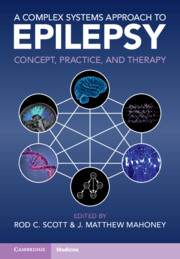Book contents
- A Complex Systems Approach to Epilepsy
- A Complex Systems Approach to Epilepsy
- Copyright page
- Contents
- Contributors
- Chapter 1 Introduction
- Chapter 2 Systems Biology Approaches to the Genetic Complexity of Epilepsy
- Chapter 3 Transcriptomic and Epigenomic Approaches for Epilepsy
- Chapter 4 Phenomenological Mesoscopic Models for Seizure Activity
- Chapter 5 Personalized Network Modeling in Epilepsy
- Chapter 6 The Baseline and Epileptiform EEG
- Chapter 7 Neuronal Approaches to Epilepsy
- Chapter 8 Mapping Epileptic Networks with Scalp and Invasive EEG
- Chapter 9 A Neuroimaging Network-Level Approach to Drug-Resistant Epilepsy
- Chapter 10 Epilepsy as a Complex Network Disorder
- Index
- References
Chapter 1 - Introduction
Published online by Cambridge University Press: 06 January 2023
- A Complex Systems Approach to Epilepsy
- A Complex Systems Approach to Epilepsy
- Copyright page
- Contents
- Contributors
- Chapter 1 Introduction
- Chapter 2 Systems Biology Approaches to the Genetic Complexity of Epilepsy
- Chapter 3 Transcriptomic and Epigenomic Approaches for Epilepsy
- Chapter 4 Phenomenological Mesoscopic Models for Seizure Activity
- Chapter 5 Personalized Network Modeling in Epilepsy
- Chapter 6 The Baseline and Epileptiform EEG
- Chapter 7 Neuronal Approaches to Epilepsy
- Chapter 8 Mapping Epileptic Networks with Scalp and Invasive EEG
- Chapter 9 A Neuroimaging Network-Level Approach to Drug-Resistant Epilepsy
- Chapter 10 Epilepsy as a Complex Network Disorder
- Index
- References
Summary
Complex systems theory is a nebulous field whose overarching goal is to understand the dynamical behavior of systems consisting of many interconnected component parts. It has attracted widespread interest from many domains that study examples of such systems, including ecologists, sociologists, engineers, artificial intelligence researchers, condensed matter physicists, neuroscientists, and many others. The results of these collected, multi-disciplinary efforts have not been so much a comprehensive theory of Complex Systems (capital-C, capital-S), but rather a set of techniques, analogies, and attitudes toward problem solving that emphasize interactions and dynamics over individual components and their functions. The chapters are written in a complex adaptive systems frame and therefore it is useful to provide a provisional theoretical description of such systems. Following Holland [1], a generalizable description of complex adaptive systems is that they are collections of relatively simple agents that have the property that they can aggregate, so that collections of agents can form meta-agents (and meta-meta-agents etc.) with higher-order structure. These aggregates interact nonlinearly, so that the aggregate behavior of a collection of agents is qualitatively different from the behavior of the individual agents. The interactions among agents mediate flows of materials or information. Finally, the agents are typically diverse with distinct specialties that are optimized through adaptation to selective pressures in their environments.
- Type
- Chapter
- Information
- A Complex Systems Approach to EpilepsyConcept, Practice, and Therapy, pp. 1 - 4Publisher: Cambridge University PressPrint publication year: 2023



